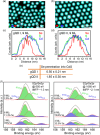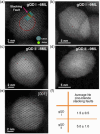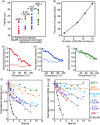From Inside Out: How the Buried Interface, Shell Defects, and Surface Chemistry Conspire to Determine Optical Performance in Nonblinking Giant Quantum Dots
- PMID: 40213516
- PMCID: PMC11935896
- DOI: 10.1002/smsc.202300092
From Inside Out: How the Buried Interface, Shell Defects, and Surface Chemistry Conspire to Determine Optical Performance in Nonblinking Giant Quantum Dots
Abstract
"Giant" or core/thick-shell quantum dots (gQDs) are an important class of solid-state quantum emitter characterized by strongly suppressed blinking and photobleaching under ambient conditions, and reduced nonradiative Auger processes. Together, these qualities provide distinguishing and useful functionality as single- and ensemble-photon sources. For many applications, operation at elevated temperatures and under intense photon flux is desired, but performance is strongly dependent on the synthetic method employed for thick-shell growth. Here, a comprehensive analysis of gQD structural properties "from the inside out" as a function of shell-growth method is reported: successive ionic layer adsorption and reaction (SILAR) and high-temperature continuous injection (HT-CI), or sequential combinations of the two. Key correlations across synthesis methods, structural features (interfacial alloying, stacking-fault density and surface-ligand identity), and performance metrics (quantum yield, single-gQD photoluminescence under thermal/photo stress, charging behavior and quantum-optical properties) are identified. Surprisingly, it is found that interfacial alloying is the strongest indicator of gQD stability under stress, but this parameter is not the determining factor for Auger suppression. Furthermore, quantum yield is strongly influenced by surface chemistry and can approach unity even in the case of high shell-defect density, while introduction of zinc-blende stacking faults increases the likelihood that a gQD exhibits charged-state emission.
Keywords: giant quantum dots; interfacial alloying; materials-by-design; structure–function correlations.
© 2023 The Authors. Small Science published by Wiley‐VCH GmbH.
Conflict of interest statement
The authors declare no conflict of interest.
Figures







Similar articles
-
Elucidation of two giants: challenges to thick-shell synthesis in CdSe/ZnSe and ZnSe/CdS core/shell quantum dots.J Am Chem Soc. 2015 Mar 25;137(11):3755-8. doi: 10.1021/jacs.5b00313. Epub 2015 Mar 11. J Am Chem Soc. 2015. PMID: 25746140
-
PbS/CdS Quantum Dot Room-Temperature Single-Emitter Spectroscopy Reaches the Telecom O and S Bands via an Engineered Stability.ACS Nano. 2021 Jan 26;15(1):575-587. doi: 10.1021/acsnano.0c05907. Epub 2020 Dec 31. ACS Nano. 2021. PMID: 33381968
-
New insights into the complexities of shell growth and the strong influence of particle volume in nonblinking "giant" core/shell nanocrystal quantum dots.J Am Chem Soc. 2012 Jun 13;134(23):9634-43. doi: 10.1021/ja212032q. Epub 2012 May 31. J Am Chem Soc. 2012. PMID: 22578279
-
Fundamental Properties in Colloidal Quantum Dots.Adv Mater. 2018 Oct;30(41):e1801442. doi: 10.1002/adma.201801442. Epub 2018 Jun 19. Adv Mater. 2018. PMID: 29923230 Review.
-
Origin and control of blinking in quantum dots.Nat Nanotechnol. 2016 Aug 3;11(8):661-71. doi: 10.1038/nnano.2016.140. Nat Nanotechnol. 2016. PMID: 27485584 Review.
References
-
- Chen Y., Vela J., Htoon H., Casson J. L., Werder D. J., Bussian D. A., Klimov V. I., Hollingsworth J. A., J. Am. Chem. Soc. 2008, 130, 5026. - PubMed
-
- Mahler B., Spinicelli P., Buil S., Quelin X., Hermier J.-P., Dubertret B., Nat. Mater. 2008, 7, 659 - PubMed
-
- Ghosh Y., Mangum B. D., Casson J. L., Williams D. J., Htoon H., Hollingsworth J. A., J. Am. Chem. Soc. 2012, 134, 9634. - PubMed
LinkOut - more resources
Full Text Sources
